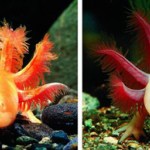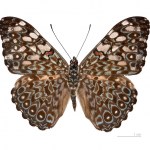Life Sciences
Back when Darwin was a student at Cambridge, he read, and almost memorised the Rev William Paley's Natural Theology, and thereafter remained impressed by the obvious adaptiveness of the parts of organisms and their interrelations. As is well known, he gave an explanation differently to Paley's external intelligence that designs all these facets of life - instead he claimed that natural selection, a process like Adam Smith's "hidden hand" explanation for the functioning of economies, was enough to explain adaptation.
I have long thought that Darwin was too much in thrall to the traditions…
I've said it before and I'm sure I'll be saying it again: as a life-long zoology nerd, one of my greatest frustrations has always been the fact that there are so many animals that get mentioned - only ever mentioned - but never elaborated upon. I've always liked Axolotls Ambystoma mexicanum, and among the world's unusual amphibians this has got to be one of the most familiar, thanks of course to its widespread use in the pet trade and as a laboratory animal [assortment of captive axolotls show above]. As everyone knows, the Axolotl is neotenous: it retains juvenile characters into sexual…
Dung Happens And Helps Scientists: Scoop On Poop And Climate Change:
When scientists around the world think of dung, they think of Jim Mead. Mead, a researcher at Northern Arizona University, is one of the world's foremost authorities on animal dung, and he's got the poop to prove it.
Neanderthals Moved From Place To Place, Tooth Analysis Shows:
A 40,000-year-old tooth has provided scientists with the first direct evidence that Neanderthals moved from place to place during their lifetimes. In a collaborative project involving researchers from the Germany, the United Kingdom, and Greece,…
tags: Scandentia, tree shrew, photography, subway art, AMNH, NYC, NYCLife
This might be a tree shrew (but which species?)
as portrayed in tiles on the walls of the NYC uptown subway stop (A-B-C)
at 81st and Central Park West. (ISO, no zoom, no flash).
Image: GrrlScientist 2008. [wallpaper size].
Read more about the AMNH tile artworks and see the AMNH tile artworks photographic archives -- with all the animals identified.
-- If you can tell me what this thing is, I'd be much obliged.
The Boneyard. This is approximately the 13th installment of The Boneyard Web Carnival, dated February 9th, plus or minus a week or so. In paleontology, we do not concern ourselves with trifles such as exact dates.
The Boneyard web carnival is about fossils, and bones, paleontology and taphonomy. It is about anything boney except actual boneyards, although actual boneyards would be of interest as well because we are a morbid, bone loving bunch.
The previous edition of the boneyard was at The Dragon's Tales. Check the…
New York's subway station at 81st and Central Park West (CPW), also known as the AMNH subway station, was first opened on 10 September 1932, and rennovation of this station was completed in 1999 after the planetarium had been added to the Natural History Museum in 1990 (at a great cost that still has not been paid off, might I add). The art at this subway station was produced by the MTA Arts for Transit Design Team in cooperation with the Museum of Natural History and is a study of the evolution of life from the big bang to the present day. The entire collection at this station is entitled…
Chapters read:1, 2, 3, 4, 5, 6 and 7.
And so with the completion of the 7th chapter the first half, book I of The Structure of Evolutionary Theory, ends. From this point on we shift from history of science to science proper. At over 1,300 pages of narrative prose (add index, bibliography, etc., and it weighs in at nearly 1,450 pages) this is a multi-course meal. But judging from the initial comments when I began my trek through this undiscovered Gouldian land the author started with some rather unappetizing starters which suppressed rather than whetted the eagerness of many for future…
tags: pangolin, animals, photography, subway art, AMNH, NYC, NYCLife
I think this is a species of pangolin, Manis species,
as portrayed in tiles on the walls of the NYC uptown subway stop (A-B-C)
at 81st and Central Park West. (ISO, no zoom, no flash).
Image: GrrlScientist 2008. [wallpaper size].
Read more about the AMNH tile artworks and see the AMNH tile artworks photographic archives -- with all the animals identified.
Banded mongoose (Mungos mungo) are a gregarious animals that, like some of their close relatives, use termite mounds for food and shelter. They are one of the few animals I've featured here that are not presently threatened or at risk of extinction, and a WWF map of the range of the species indicates that banded mongoose inhabit the majority of sub-Saharan Africa.
tags: researchblogging.org, evolution, bird-dinosaur split, dinosaurs, birds, rocks-versus-clocks, fossil record, molecular clocks
The first feathered dinosaur fossil found in China -- Sinosauropteryx.
The feathers can be seen in the dark line running along the specimen's back.
Image: Mick Ellison, AMNH [larger view]
There is a lot of controversy among scientists regarding when modern birds first appeared. The current fossil record suggests that modern birds appeared approximately 60-65 million years ago when the other lineages of dinosaurs (along with at least half of all terrestrial…
Panoplosaurus mirus was a large nodosaurid (reaching 6 m) and a particularly close relative of the even larger Edmontonia (for a quick intro to nodosaurids see the day 2 article). One of several Canadian dinosaurs from the Campanian Dinosaur Park Formation named by Lawrence Lambe, Panoplosaurus was described in 1919 for a skeleton collected by Charles M. Sternberg. As in Edmontonia but unlike other nodosaurids, Panoplosaurus lacked premaxillary teeth and grew an oval scute in the cheek cavity adjacent to its teeth. These nodosaurids must, therefore, have possessed fleshy cheeks (an…
There are 43 new articles in PLoS ONE this week, and these I find most interesting at first glance - you look around, comment, rate, annotate, send tracbacks....
A Three-Stage Colonization Model for the Peopling of the Americas:
We evaluate the process by which the Americas were originally colonized and propose a three-stage model that integrates current genetic, archaeological, geological, and paleoecological data. Specifically, we analyze mitochondrial and nuclear genetic data by using complementary coalescent models of demographic history and incorporating non-genetic data to enhance the…
One of the most compelling argument that the story of Noah's Ark is made up is the implausibility of having animals like tigers and lions together with animals like lambs and deer on the same boat for very long. The big carnivores would eventually eat the little cute furry things. The bunnies would be the first to go. But new evidence, shown on the Miracle Pet Show disproves this objection.
So, if it is god's will, or if people just darn try hard enough, anybody and anything can get along with anything and anybody. Put that on an inspirational poster and hang it, I say!
Or is there…
199 years ago today, Charles Robert Darwin was born in Shrewsbury, Shropshire, England at the home of his family (known as the Mount). By pure coincidence, Charles would have published one of the most important books ever written 50 years later in 1859, and next year will mark not only the bicentennial of Darwin's birth but also the 150th anniversary of On the Origin of Species by Natural Selection. Indeed, next year will give us cause for raucous celebration, but this year I have been asking myself why Darwin's work is important enough to still get excited about it nearly a century and a…
"Disease" is a big word. I'd like to address this question by focusing on the difference, or lack of difference, between a poison, a disease, and a yummy thing to eat. It turns out that they may all be the same. Yet different.
Phenylketonuria (fee-null-keet-o-noo-ria), mercifully also known as "PKU" (pee - kay - you) is a disorder in which the amino acid phenylalanine is not broken down by an enzyme (phenylalanine hydroxylase) and thus accumulates in the body as phenylpyruvic acid.
This is bad because phenylpyruvic acid interferes with normal development of neural tissues.
In western…
Thus, from the war of nature, from famine and death, the most exalted object which we are capable of conceiving, namely, the production of the higher animals, directly follows. There is grandeur in this view of life, with its several powers, having been originally breathed into a few forms or into one; and that, whilst this planet has gone cycling on according to the fixed law of gravity, from so simple a beginning endless forms most beautiful and most wonderful have been, and are being, evolved.
- Charles R. Darwin, the closing paragraph of the Origin Of Species, 1st edition, 1859.
Support…
tags: Birds in the News, BirdNews, ornithology, birds, avian, newsletter
The White-crested Elaenia, Elaenia albiceps, on Texas' South Padre Island.
Image appears here with the kind permission of the photographer, Erik Breden, who retains the copyright to the image [larger view and More pictures of this bird]. [call notes of this bird, linked from Martin Reid, who recorded it onsite (mp3)].
The really hot bird news in the United States is the presence of a White-crested Elaenia on Texas' South Padre Island. This is the first time this species has been seen in North America, so there are…
Welcome to day 2 of the 'ankylosaur week' series - for the background on this go see day 1 on Hungarosaurus. Before talking about today's ankylosaur, here's a quick 'everything you wanted to know about ankylosaurs but were afraid to ask'. Ankylosaurs were ornithischian dinosaurs from the Jurassic and Cretaceous, they have a highly modified skull where the sutures are closed, the external openings are mostly or entirely closed, the dorsal surface is covered with thick bony layers and bony bosses, and the small teeth are inset from the jaw margins. Horns often project from the cheek and rear…
When reading The Voyage it is impossible to miss the observation that much of the time Darwin was engaged in adolescent boy behavior: Pulling the heads off insects, noting how long they would wiggle after cut in half, closely examining the ooze and guts, occupied much of his time. Obviously, careful observation and a strong stomach were not all that was required to think up Natural Selection and his other theories, or the Origin of Species would have been written dozens of times by dozens of grown up kids.
In the following passages, Darwin is still along the Atlantic Coast, in "The…
Tonight I finished Rudwick's Georges Cuvier, Fossil Bones, and Geological Catastrophes, and I certainly feel that I have a better understand of Cuvier's work than I did previously (although the subject of his embranchments and debates with Geoffrey only received a fleeting mention). What is truly curious, though, is that Cuvier was not a biblical literalist and yet did not seem to favor a mechanism by which the various unique fossil taxa he described could have come into existence. He noted that an "age of reptiles" likely preceded an "age of mammals" (divided by a catastrophic revolution…

